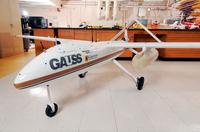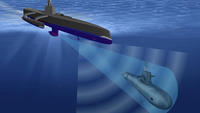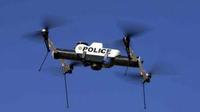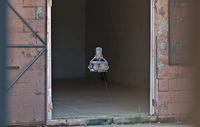-
Nebraska lawmakers look to limit police drone use
The Federal Aviation Administration says there will be around 30,000 commercial and government drones flying over the United States in the next ten years. The business of selling and servicing domestic drones is projected to grow into a $90 billion industry. Lawmakers at the federal and state level say that to prevent these drone from encroaching on citizens’ privacy, it is time to define what they can do, where, and when.
-
-
Aerial platform helps in developing lightweight sensors for UAVs

A research team at the Georgia Tech Research Institute (GTRI) is developing an airborne testing capability for sensors, communications devices, and other airborne payloads. This aerial test bed, called the GTRI Airborne Unmanned Sensor System (GAUSS), is based on an unmanned aerial vehicle (UAV) made by Griffon Aerospace and modified by GTRI.
-
-
Police depts. reviews policy on retaining data from license plate readers
License plate readers (LPRs) have been used more and more by law enforcement agencies across the United States, but as they gain popularity in law enforcement, they have become the subject of debate, and concern, in many local governments.
-
-
Unmanned vessel for continuous tracking of enemy submarines

DARPA looking for an unmanned naval vessel that can seek out and track quiet diesel submarines, forcing them to return to base and thus protecting friendly ships from attack
-
-
Proliferation of license plate readers worry privacy advocates
Automated License Plate Recognition (ALPR) technology has taken off in recent years, and the police says it is the greatest innovation since fingerprints and DNA; the technology has changed the way police finds cars connected to crimes, but in the process it has upset many privacy advocates
-
-
Major surveillance law heading toward its own end-of-year cliff

While coverage of the tense negotiations over a resolution to the fiscal cliff threat has dominated the media, the Foreign Intelligence Surveillance Amendments of 2008 is heading for a cliff of its own, as the provisions of the act are set to expire at the end of the year
-
-
Seattle debates use of drones by police
The debate between law enforcement and privacy advocates over the use of UAVs is now taking place in Seattle; since President Obama signed a bill in February pushing the Federal Aviation Administration (FAA) to allow the use of civilian drones in America by 2015, many law enforcement agencies have been preparing to use drones
-
-
Privacy advocates succeed in delaying drone purchase by California country sheriff

Congress earlier this year passed legislation earlier this year ordering the Federal Aviation Administration (FAA) to accelerate the approval of the use of unmanned aerial vehicles (UAVs) for law enforcement and other domestic purposes, and, law enforcement agencies around the country are moving to purchase drones; Alameda Country, California planned to buy a drone, but action by the ACLU and the Electronic Frontier Foundation forced the county to hold a public hearing on drone use and formulate guideless for, and set limits on, drone use by police
-
-
Technology emulates the Blind Cave Fish to help underwater vessels navigate with ease
Scientists have invented a “sense-ational” device, similar to a string of feelers found on the bodies of the Blind Cave Fish, which enables the fish to sense their surrounding and so navigate easily; using a combination of water pressure and computer vision technology, the sensory device is able to give users a 3-D image of nearby objects and map its surroundings
-
-
Sudan says Israel using electronically equipped vultures as spies
Sudanese security forces have captures what they describe as an electronically tagged vulture which was dispatched by the Israeli military on a surveillance mission over Sudan; the Sudanese claimed the vulture was equipped with a camera, a solar-powered satellite uplink, and a GPS device; the Sudanese also claimed that the surveillance gear was produced by the Hebrew University in Jerusalem, and that it was stamped with the university’s logo
-
-
Detecting tunnels -- used to smuggle drugs, weapons, or people – is not easy
It seems reasonable to assume that it would be easy to use seismic waves to find tunnels dug by smugglers of drugs, weapons, or people, but this assumption is wrong; scientists are trying to get a better look at the ground around tunnels to learn why seismic data finds some tunnels but not others – and come up with a seismic detection process for the border and other areas where tunnels pose a security threat
-
-
Two small, long-endurance UAVs unveiled

Danvers, Massachusetts-based CyPhy Works, a new robotics company, the other day unveiled two revolutionary small unmanned air vehicles (UAVs): EASE and PARC; the Extreme Access System for Entry (EASE) is an indoor flying UAV to help police, soldiers, and inspectors remain at safe standoff distances; the Persistent Aerial Reconnaissance and Communications (PARC) is designed to fly vertically and remain hovering for unprecedented long durations without operator intervention
-
-
CBP wants more drones, but lawmakers want more details about their use
The U.S. Customs and Border Protection (CBP) wants to have a fleet of twenty-four drones to patrol the northern and southern borders of the United States, but Congress has yet to appropriate funding beyond the first ten drones; so far in 2012, drones have been credited with leading to more arrests and drug seizures than ever before, but their contribution is still small
-
-
U.S. denies Iran’s claim that it had captured a U.S. surveillance drone
Drones are used extensively by the United States to monitor not only Iran’s nuclear activities, but also its military moves on land and at sea. Iran’s state television reported on Tuesday that Iran’s Revolutionary Guards Corps naval forces captured an American drone that entered Iranian airspace over the Persian Gulf. The U.S. Navy quickly denied the claim
-
-
U.S. skies may soon be open to drones
Unmanned drones are cheaper than manned aircraft and can be used in a variety of ways, such as assessing environmental threats and damage from natural disaster, tracking criminals trying to escape on a highway, and assessing wildfires; according to an FAA prediction, 30,000 drones could be flying in the United States in less than twenty years; lawmakers and privacy advocates want the use of these drones more tightly regulated
-
- All
- Regional
- Water
- Biometrics
- Borders/Immig
- Business
- Cybersecurity
- Detection
- Disasters
- Government
- Infrastructure
- International
- Public health
- Public Safety
- Communication interoperabillity
- Emergency services
- Emergency medical services
- Fire
- First response
- IEDs
- Law Enforcement
- Law Enforcement Technology
- Military technology
- Nonlethal weapons
- Nuclear weapons
- Personal protection equipment
- Police
- Notification /alert systems
- Situational awareness
- Weapons systems
- Sci-Tech
- Sector Reports
- Surveillance
- Transportation
Advertising & Marketing: advertise@newswirepubs.com
Editorial: editor@newswirepubs.com
General: info@newswirepubs.com
2010-2011 © News Wire Publications, LLC News Wire Publications, LLC
220 Old Country Road | Suite 200 | Mineola | New York | 11501
Permissions and Policies
Editorial: editor@newswirepubs.com
General: info@newswirepubs.com
2010-2011 © News Wire Publications, LLC News Wire Publications, LLC
220 Old Country Road | Suite 200 | Mineola | New York | 11501
Permissions and Policies
